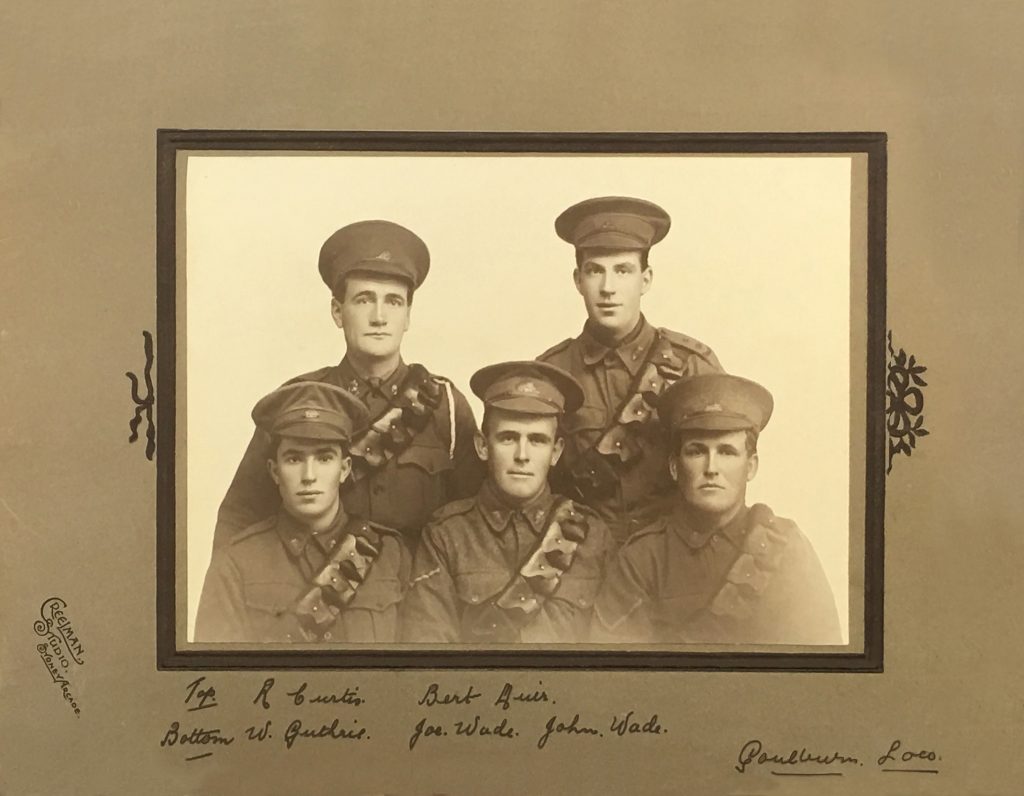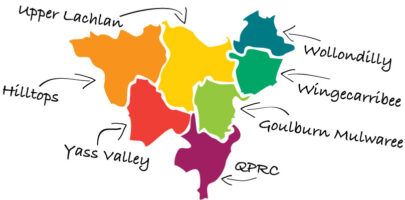The Goulburn Hub: Great Southern Line
The stories of returning soldiers on the great southern line: Goulburn, Moss Vale and Picton
The stories of railway workers who enlisted in the First World War are based on information gathered from families and official war records. References to information collected are included.
Summary information about each railway hub station and the character of its location is provided as context to each set of stories.
Goulburn hub
Character of Hub
Goulburn hub was a principal railway depot on the Great Southern Line. It played an important role in town and district life as a major employer and contributor to social life. Its identity centred on the industrial work of running and maintaining trains. Its large Locomotive Department (from the 1930s identified as ‘Mechanical’ on employment cards) carried out major overhauls and regular service work on locomotives and rolling stock. ‘Loco’ employees included engine crew as well as tradespeople such as boilermakers and fitters as well as labourers. A barracks was provided for crew resting between shifts. They were called to work by a Call Boy. By the end of the First World War a 42 road Roundhouse had been added for Loco work. The head of Loco was the Steam Shed Inspector. Goulburn Loco district included Tallong, Canberra, Moss Vale, Queanbeyan, Bombala, Michelago and Cooma stations.
Homefront character
The whistles of engines stabled at Loco contributed to wartime events such as farewelling railway workers off to the front and greeting returning soldiers. On Armistice Day they signaled the news and the beginning of peace celebrations (GEPP 9/11/1918 p2). The station, like others on the line, was the site of welcomes and farewells which included the local band. Goulburn railway management erected an honour board at the station for railway workers who served in the War.
Stories
The detailed Goulburn stories collected to date are about Loco employees. Bob McKillop notes the industrial nature of Loco work and the strong role of unions in its workforce. He identifies overalls as the usual ‘uniform’ with ‘a driver’s cap or a battered Akubra for locomotive crew and collar and tie for supervisors’. Shunting work also appears on the employment cards of Goulburn loco workers. Marshalling goods wagons was particularly dangerous and bonds between members of gangs were strong. They generally wore ‘shorts and singlet and a battered greasy hat’ (see appendix ii). The additional story of Charles Leslie Newman who was clerk to the District Superintendent at Goulburn, highlights the district-wide role of Goulburn and its importance on the Great Southern Line.
The Goulburn Loco Five
Five young men working up the ladder of engine cleaner, fireman, loco driver at Goulburn loco depot, enlisted together in Sydney in 1916 and had their photo taken together to mark the occasion. They were connected by work and family. Two were brothers – Joseph and John Wade – born in the region. Two were British migrants – Robert Muir and Robert Curtis. William Guthrie’s family had several generations of history in the area. After the War Robert Curtis married William Guthrie’s sister, Daisy. They all returned from the War to work on the Southern Line in their positions at Goulburn Loco. Three of them stayed. John Wade and William Guthrie left the Southern Line but continued to work as drivers for NSWGR until they retired. Robert Curtis retired early as a result of his war injuries. Joseph Wade died suddenly on the job at the age of 58. Robert Muir exchanged railway work in Goulburn for managing a general store in Hornsby.


The Goulburn Loco Five
Back l-r: Robert Curtis, Robert Muir
Front l-r: William Guthrie, Joseph Wade, John Wade
Album photo courtesy Kate Olsson (granddaughter Robert Curtis)
Photo full length courtesy Judith Guthrie (granddaughter William Guthrie), also held by Robyn Cummins (granddaughter Robert Muir)
We acknowledge Aboriginal people as the traditional custodians of the lands where we create, live & work.
© 2026 Southern Tablelands Arts. All Rights Reserved




